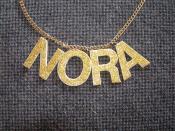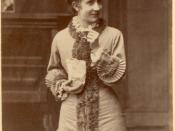In reading Ibsen's A Doll's House today, one may find it hard to imagine how daring it seemed at the time it was written one hundred years ago. Its theme, the emancipation of a woman, makes it seem almost contemporary.
In Act I, there are many clues that hint at the kind of marriage Nora and Torvald have. It seems that Nora is a doll controlled by Torvald. She relies on him for everything, from movements to thoughts, much like a puppet who is dependent on its puppet master for all of its actions. The most obvious example of Torvald's physical control over Nora is his reteaching her the tarantella. Nora pretends that she needs Torvald to teach her every move in order to relearn the dance. The reader knows this is an act, and it shows her submissiveness to Torvald. After he teaches her the dance, he proclaims 'When I saw you turn and sway in the tarantella--my blood was pounding till I couldn't stand it' showing how he is more interested in Nora physically than emotionally.
When Nora responds by saying 'Go away, Torvald! Leave me alone. I don't want all this', Torvald asks 'Aren't I your husband?'. By saying this, he is implying that one of Nora's duties as his wife is to physically pleasure him at his command. Torvald also does not trust Nora with money, which exemplifies Torvald's treating Nora as a child. On the rare occasion when Torvald gives Nora some money, he is concerned that she will waste it on candy and pastry; in modern times, this would be comparable to Macauly Culkin being given money, then buying things that 'would rot his mind and his body' in the movie Home Alone. Nora's duties, in general, are restricted to caring for...



Very useful
i really liked your structure and style in this essay, it sounds really sophisticated. Your ideas were great and very useful. thanks for posting this.
0 out of 0 people found this comment useful.